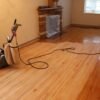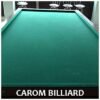Home Improvement
The Science of Silence: Exploring the Benefits of Acoustic Insulation
Sound is an integral part of our daily lives. It can be soothing, inspiring, or even energising. However, excessive noise can have a detrimental effect on our well-being. Studies have shown that prolonged exposure to noise pollution can lead to stress, sleep disturbances, and even health issues like hypertension and cardiovascular diseases. This is where the science of acoustic insulation comes into play.
Acoustic insulation is the process of using materials that minimise or eliminate sound transmission. By creating a barrier between the source of noise and the surrounding environment, acoustic insulation helps to reduce the impact of unwanted sounds. Whether it’s the bustling traffic outside or the loud conversations in a neighbouring room, acoustic insulation can provide a much-needed respite from the noise that surrounds us.
But how does acoustic insulation work? It’s all about understanding the properties of sound. Sound is created when an object vibrates, causing air particles to move and generate waves. These waves travel through the air until they reach our ears, where they are interpreted as sound. Acoustic insulation disrupts this process by absorbing, reflecting, or dissipating sound waves, preventing them from reaching our ears.
The benefits of acoustic insulation in residential settings
Our homes should be a sanctuary, a place where we can relax, unwind, and rejuvenate. However, external noises can easily infiltrate our living spaces, disrupting our peace and tranquility. This is where acoustic insulation can make a significant difference.
One of the main benefits of acoustic insulation in residential settings is improved sleep quality. Studies have shown that exposure to noise during sleep can lead to fragmented sleep patterns and decreased sleep quality. By installing acoustic insulation in bedrooms, homeowners can create a quiet and peaceful environment, free from the disturbances of traffic, neighbours, or other external noises.
Additionally, acoustic insulation can enhance the overall comfort and well-being of residents. It reduces the need for raising voices to overcome background noises, leading to better communication and less strain on our vocal cords. It also provides a sense of privacy by preventing sound from travelling between rooms, allowing family members to enjoy their personal spaces without unnecessary interruptions.
Moreover, acoustic insulation can help reduce energy consumption by acting as a thermal barrier. It prevents heat loss through walls and ceilings, making our homes more energy-efficient and reducing the need for excessive heating or cooling. This not only benefits the environment but also helps homeowners save on their energy bills.
How acoustic insulation improves workplace productivity
In today’s fast-paced and noisy work environments, productivity can often be compromised. Constant distractions, such as ringing phones, conversations, and office equipment, can hinder concentration and disrupt workflow. This is where acoustic insulation can play a vital role.
Acoustic insulation in the workplace creates a quieter environment, allowing employees to focus on their tasks without unnecessary interruptions. Reducing background noise enhances concentration and increases productivity. Studies have shown that employees working in quieter offices exhibit higher levels of job satisfaction, creativity, and overall performance.
Furthermore, acoustic insulation can improve the acoustics of meeting rooms and conference halls. By reducing reverberation and echo, it enhances speech intelligibility and ensures effective communication during important discussions or presentations. This not only benefits the employees but also leaves a positive impression on clients or visitors.
Additionally, acoustic insulation can contribute to a healthier and safer work environment. Prolonged exposure to high levels of noise can lead to stress, fatigue, and even hearing loss. By reducing noise pollution, acoustic insulation helps protect the well-being of employees, ensuring their long-term health and productivity.
The role of acoustic insulation in healthcare facilities
Healthcare facilities, such as hospitals and clinics, are places where silence is of utmost importance. Patients need a quiet and calm environment to aid their recovery, and healthcare professionals require focused concentration to provide the best care. Acoustic insulation plays a crucial role in achieving these objectives.
One of the primary benefits of acoustic insulation in healthcare facilities is the reduction of noise levels. By minimising the transmission of sounds from one area to another, it helps create a peaceful and serene atmosphere for patients. This is particularly important in areas such as patient rooms, intensive care units, and recovery areas, where rest and sleep are essential for healing.
Moreover, acoustic insulation can improve speech privacy in healthcare settings. Confidentiality is crucial in medical environments, and patients’ conversations should not be overheard by others. Acoustic insulation materials and techniques can help create sound barriers, ensuring that sensitive information remains private and secure.
Additionally, acoustic insulation can contribute to the overall safety of healthcare facilities. In emergency situations, clear communication is vital for swift action and coordination. By reducing background noise and improving the clarity of announcements and alarms, acoustic insulation ensures that important messages are heard and understood, promoting effective emergency response.
Acoustic insulation for educational institutions
Education is the foundation of our society, and educational institutions play a crucial role in shaping young minds. However, the learning process can be hampered by external noises, making it difficult for students and teachers to concentrate. Acoustic insulation can create a conducive learning environment, benefiting both students and educators.
One of the key benefits of acoustic insulation in educational institutions is improved speech intelligibility. Clear and intelligible communication is essential for effective teaching and learning. By reducing background noise and echo, acoustic insulation enhances the clarity of speech, ensuring that students can hear and understand their teachers’ instructions without difficulty.
Moreover, acoustic insulation can enhance students’ concentration and focus. Studies have shown that excessive noise levels in classrooms can lead to decreased academic performance and cognitive impairment. By minimising external noises, acoustic insulation helps create a quiet and calm environment, allowing students to concentrate on their studies and absorb information more effectively.
Furthermore, acoustic insulation can contribute to the overall well-being of students and teachers. Noise pollution in schools can lead to increased stress levels and fatigue, affecting both mental and physical health. By reducing noise levels, acoustic insulation promotes a healthier and more productive learning environment, fostering academic success and personal development.
Acoustic insulation in commercial and industrial settings
Commercial and industrial environments are often characterised by high levels of noise. Whether it’s the hum of machinery, the clatter of equipment, or the constant hustle and bustle of employees, excessive noise can have a significant impact on productivity and employee well-being. Acoustic insulation can help mitigate these challenges.
One of the main benefits of acoustic insulation in commercial and industrial settings is improved employee comfort. Excessive noise levels can lead to increased stress, fatigue, and even hearing loss. By reducing noise pollution, acoustic insulation creates a more comfortable and healthy working environment, enhancing employee satisfaction and well-being.
Moreover, acoustic insulation can improve communication and overall workplace efficiency. In noisy environments, employees often need to raise their voices or rely on visual cues to communicate effectively. This can be tiring and time-consuming. By reducing background noise, acoustic insulation ensures clear and uninterrupted communication, allowing employees to work more efficiently and collaboratively.
Additionally, acoustic insulation can help meet regulatory requirements and ensure compliance with health and safety standards. Many industries have specific noise control regulations that need to be adhered to. By installing effective acoustic insulation, businesses can create a safer and more compliant working environment, avoiding potential penalties and legal issues.
Different types of acoustic insulation materials
Acoustic insulation materials come in various forms, each with its own unique properties and applications. Here are some commonly used types of acoustic insulation materials:
- Fiberglass: Fiberglass insulation is one of the most widely used materials for acoustic insulation. It consists of fine glass fibres that trap air and absorb sound waves. Fiberglass insulation is effective in reducing both airborne and impact noise, making it suitable for a wide range of applications.
- Mineral Wool: Mineral wool, also known as rock wool or stone wool, is another popular choice for acoustic insulation. It is made from natural minerals, such as basalt or diabase, which are melted and spun into fibres. Mineral wool has excellent sound-absorbing properties and can withstand high temperatures, making it ideal for industrial applications.
- Cellulose: Cellulose insulation is made from recycled paper treated with fire-retardant chemicals. It is a cost-effective and eco-friendly option for acoustic insulation. Cellulose insulation is particularly effective in reducing airborne noise and can be used in walls, ceilings, and floors.
- Acoustic Foam: Acoustic foam is a lightweight and porous material that absorbs sound waves. It is commonly used in recording studios, home theatres, and other areas where sound quality is important. Acoustic foam is available in various shapes and sizes, allowing for customised installation.
- Mass Loaded Vinyl: Mass loaded vinyl, or MLV, is a dense and flexible material that acts as a sound barrier. It is often used to reduce airborne noise and can be installed in walls, ceilings, and floors. MLV is an effective solution for blocking sound transmission and is commonly used in commercial and residential applications.
Factors to consider when choosing acoustic insulation
When selecting acoustic insulation materials, several factors need to be taken into consideration. Here are some key factors to consider:
- Noise Source: Identify the primary source of noise and its characteristics. This will help determine the appropriate type and thickness of acoustic insulation required.
- Sound Transmission Class (STC): STC is a rating system that measures the effectiveness of a material in reducing sound transmission. Consider the desired STC rating when choosing acoustic insulation materials.
- Environmental Considerations: Take into account any specific environmental factors, such as temperature, humidity, or fire resistance requirements. Some materials may perform better under certain conditions.
- Installation Ease: Consider the ease of installation and the compatibility of the chosen acoustic insulation material with existing structures. Some materials may require professional installation, while others can be easily installed as a DIY project.
- Budget: Determine the available budget for acoustic insulation and choose materials that offer the best balance between performance and cost-effectiveness.
Conclusion:
In a world where noise pollution is becoming increasingly prevalent, investing in acoustic insulation is essential for creating a peaceful and serene environment. Whether it’s in our homes, workplaces, healthcare facilities, educational institutions, or commercial and industrial settings, acoustic insulation can have a significant impact on our well-being, productivity, and overall quality of life.
By understanding the science behind acoustic insulation and exploring its many benefits, we can appreciate the importance of incorporating it into our daily lives. From improving sleep quality and increasing productivity to enhancing communication and reducing stress, acoustic insulation has the power to transform our environments and bring us closer to the beauty of silence. So, let’s embrace the science of silence and create a world that is not only visually appealing but acoustically soothing as well.



















